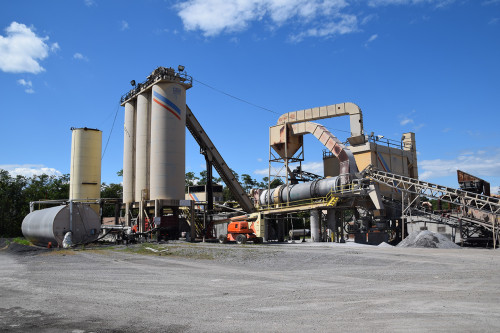Experience the Difference: Hot Mix Asphalt Paving for Regrading Projects
Experience the Difference: Hot Mix Asphalt Paving for Regrading Projects
Blog Article
Unlocking the Tricks of Hot Mix Asphalt Modern Technology
Discovering the depths of hot mix asphalt modern technology uncovers a world where careful procedures and exact formulas assemble to form our roads and infrastructure. The fusion of fillers, binders, and aggregates isn't just a building and construction job but a strategic orchestration of durability and efficiency. As we peer right into the detailed dancing of elements, a tapestry of durability and sustainability unfolds. What exists below this surface of asphaltic proficiency, and what secrets wait to be introduced in the world of leading developments?
Importance of Warm Mix Asphalt
Hot Mix Asphalt plays a crucial duty in modern infrastructure development as a result of its sturdiness and cost-effectiveness. As the most generally used paving material for roadways, freeways, and car park, Hot Mix Asphalt supplies an array of benefits that add to its significance in construction jobs. One vital benefit is its ability to hold up against rush hour tons and severe climate condition, providing a lasting and trusted surface for transportation networks. Additionally, Warm Mix Asphalt is cost-efficient in both preliminary building and construction and long-term maintenance, making it a favored option for lots of infrastructure jobs.
The toughness of Hot Mix Asphalt stems from its make-up, which includes aggregates, binder, and filler materials that are thoroughly picked and mixed to satisfy specific performance demands. Generally, the importance of Warm Mix Asphalt in framework development can not be understated, as it proceeds to be a cornerstone of contemporary building practices.
Components of Asphalt Mixes
The make-up of asphalt blends is composed of very carefully picked accumulations, binder, and filler materials that are important for attaining particular efficiency demands. Accumulations are the key part of asphalt mixes, offering toughness and stability. These accumulations can be natural, such as crushed rock or smashed stone, or artificial, like recycled products from old sidewalks. The binder, usually asphalt or asphalt cement, holds the accumulations together and offers adaptability and sturdiness to the mix. The selection of the binder is crucial as it straight affects the mix's performance in different weather condition problems. Fillers, such as hydrated lime or Rose city cement, are made use of to enhance the mix's workability and aging resistance. Angled Parking.
The mix and percentage of these parts play a considerable function in identifying the top quality and performance of the asphalt mix. Engineers carefully design the mix to meet specific requirements, thinking about elements like traffic quantity, environment problems, and sidewalk life expectancy. Proper choice and harmonizing of accumulations, binder, and fillers are essential for producing resilient, long-lasting asphalt pavements.
Mixing and Production Techniques

When the accumulations are selected, the binder, usually asphalt concrete, is included in bind the materials together. The binder's top quality and amount substantially impact the mix's stamina, adaptability, and resistance to ecological variables. In addition, fillers like moisturized lime or Portland concrete might be incorporated to improve details features of the asphalt mix, such as its workability or moisture resistance.
During production, the accumulations and binder are heated up, generally in between 250-325 ° F(121-163 ° C ), to facilitate blending and make certain appropriate finish of the aggregates. The mixing procedure must be thorough to achieve an uniform combination that promotes the desired performance attributes of the asphalt. Numerous methods, such as batch mixing or drum mixing, are utilized to achieve constant and premium asphalt blends for building and construction tasks.
Elements Influencing Asphalt Performance
Variables influencing asphalt efficiency incorporate a series of variables that influence the toughness, longevity, and total quality of asphalt pavements. One crucial aspect is the quality of materials used in the asphalt mix. The kind and resource of accumulations, the binder high quality, and the additives all play a substantial function in determining the performance of the asphalt sidewalk. The gradation of aggregates is vital as it affects the mix's stability, resistance, and workability to rutting and fracturing.

Ecological conditions likewise influence asphalt performance. Temperature level variations, moisture infiltration, and web traffic lots can all influence the architectural integrity of the sidewalk. Style factors to consider, such as sidewalk density and drain, are essential in making sure the long-lasting performance of the asphalt sidewalk. By very carefully considering these engineers, professionals and variables can enhance asphalt efficiency and boost the life span of sidewalks.
Sustainable Practices in Asphalt Innovation

WMA allows for the production and placement of asphalt blends at lower temperature levels compared to conventional hot-mix asphalt, resulting in reduced energy intake and greenhouse gas discharges. The usage of permeable asphalt blends can assist reduce stormwater drainage issues by enabling water to infiltrate via the sidewalk and into the ground, promoting natural water purification and reenergize processes.
Final Thought
Finally, hot mix asphalt technology plays a vital function in modern-day infrastructure advancement because of its resilience and cost-effectiveness. By very carefully regrading balancing elements, employing correct mixing methods, and thinking about various factors, engineers can create high-grade asphalt mixes that hold up against rush hour lots and harsh weather. Accepting lasting methods, such as making use of warm-mix innovations and recycled materials, even more boosts the ecological friendliness of asphalt innovation.
Mixing and manufacturing methods in hot mix asphalt technology involve the exact combination and processing of accumulations, binder, and fillers to produce a high-performance and resilient asphalt mix.Elements influencing asphalt performance incorporate a range of variables that impact the toughness, durability, and total high quality of asphalt sidewalks. Lasting practices in asphalt technology incorporate various campaigns intended at reducing the environmental effect of asphalt manufacturing and paving procedures. By incorporating recovered asphalt pavement (RAP) and recycled asphalt roof shingles (RAS) right into new asphalt blends, the sector can significantly decrease the usage of raw materials and energy, while also reducing garbage dump waste.
WMA enables for the production and positioning of asphalt mixes at lower temperatures compared to traditional hot-mix asphalt, resulting in reduced energy usage and greenhouse gas exhausts.
Report this page